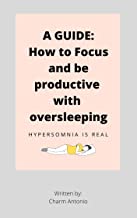Hypersomnia
Hypersomnia is a condition in which you feel excessive sleepiness during the day. It may occur even after long stretches of sleep. Another name for hypersomnia is excessive daytime sleepiness (EDS). Hypersomnia can be a primary condition or a secondary condition.
Cluster Number:
Wiki Number: W098
Diagnosis: Hypersomnia
US Patients: 5-10%
World Patients:
Sex Ratio: M+;W
Age Onset:
Brain Area:
Symptoms: lack of alertness in daytime; prolonged night sleep for 3 months;sleep drunkenness-difficulty waking up;
Progression: Most other major diseases have hypersomnias and inability to have refreshing delta sleep at night.
Causes: narcolepsy, sleep apnea, reaction to medications,
Medications: modafinil is helpful.
Therapies: Using beds only for sleep and sex helps.
Youtube Video: Breakthroughs in the Management of
Idiopathic Hypersomnia
Amazon or Library Book: A Guide: How to Focus and be productive with oversleeping
Click the text to link or order from Amazon.

